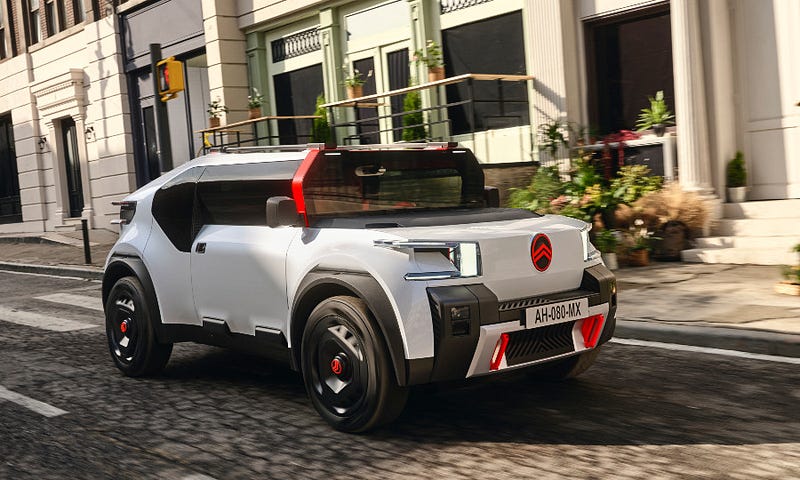Citroen Oli: The Game-Changing EV That Could Redefine Sustainability
Written on
Chapter 1: Introduction to the Citroen Oli
Electric vehicles (EVs) have garnered significant attention for their ability to offer emissions-free transportation. However, while many EVs are indeed less harmful to the environment than traditional gasoline vehicles, they still come with their own environmental costs. Research indicates that an EV must be driven approximately 20,000 miles before its total emissions become lower than those of a comparable combustion engine car. Additionally, the weight of these vehicles—often due to their large batteries—makes them unaffordable for many consumers. This is not the EV revolution we anticipated. Yet, Citroën is stepping up with its innovative model, the Oli (pronounced all-e).
Citroën describes the Oli as a departure from the norm: “Instead of being a 2,500kg ‘palace on wheels’ filled with screens and gadgets, Oli demonstrates that more can be accomplished with less.” This philosophy of efficiency and minimalism aligns perfectly with both sustainability and affordability, areas the automotive industry often overlooks. If Citroën succeeds in this endeavor, the Oli could truly be a game-changer.
“This concept car is a testament to doing more with less.”
Section 1.1: The Minimalist Design of the Oli
How has the Oli achieved its minimalist aesthetic? To begin with, consider the materials used in its construction. While the panels may appear to be conventional steel or aluminum, they are predominantly crafted from recycled plastics, which are lighter and cheaper. Remarkably, the hood, roof, and truck bed (yes, it’s a pickup!) are made from a special honeycomb-lattice cardboard, treated with polyurethane paint to match the strength of steel while weighing half as much and being waterproof. This unique material can even support the weight of a person standing on the roof without deforming! Moreover, it is fully recyclable.
Recycling plays a crucial role in the Oli's design. The vehicle incorporates 50% recycled materials and is entirely recyclable at the end of its lifespan, making it one of the first true examples of a “circular economy” vehicle.

Section 1.2: Innovative Features and Their Benefits
Citroën's ingenuity extends beyond materials. The Oli features a flat, vertical windscreen that significantly reduces glass usage, thus lowering production costs and carbon emissions while contributing to a lighter overall weight. You may wonder if this design compromises aerodynamics. Surprisingly, Citroën has integrated air ducts in the hood to channel airflow over the vehicle, effectively creating a virtual windscreen that minimizes drag.
The interior boasts a clean, uncomplicated design. The seating system consists of three components: 3D-printed cushions, an aluminum frame, and integrated air suspension for improved comfort. Instead of large screens, the Oli encourages the use of smartphones for the infotainment system, further reducing weight, cost, and environmental impact.
Chapter 2: Performance and Efficiency
Citroen Oli review – The most IMPORTANT EV I've ever driven! (batchreviews / James Batchelor) - YouTube
Despite initial impressions, the Oli's battery capacity of 40 kWh may seem inadequate. It’s nearly 40% less than that of a basic Tesla Model 3 SR. However, due to its lightweight design—only 1,000 kg (2,200 lbs), comparable to an older Lotus sports car—the Oli is surprisingly efficient. In contrast, the Model 3 SR weighs 1,726 kg, making the Oli more efficient despite its smaller battery. The Oli claims a range of 248 miles, not far behind the Model 3's 272 miles.
The reduced weight allows Goodyear to create tires for the Oli that can last up to 300,000 miles, meaning that owners may only need to replace their tires once throughout the car's lifetime—making it both economical and eco-friendly.
The smaller battery also means quicker charging times. The Oli can reach a 10% to 80% charge in just 23 minutes, thanks to its compatibility with less powerful chargers. This contrasts with the Tesla, which takes 25 minutes for a similar charge but requires a more powerful charger. With more 100 kW chargers available, especially in Europe, the Oli presents a more practical charging solution.
This Might Be The Most Important Car Of The Decade… - YouTube
The reduced charging rate contributes to lower cooling requirements and less infrastructure demand, further enhancing the battery's cost-effectiveness, weight, and environmental benefits.
With the Oli utilizing 70% less material by weight and maintaining a simpler design than the Model 3, the potential for lower production costs is significant. Estimates suggest that while the Model 3 incurs approximately $18,000 in raw materials and another $10,000 for manufacturing, the Oli could potentially be built for around $15,400 due to its simpler design and reduced material requirements.
Assuming a 25% profit margin, the estimated selling price could be around $19,250, which is less than half the cost of a standard Model 3 while offering a comparable EV range and enhanced eco-friendliness. While these figures are speculative, they indicate a promising direction for Citroën.
In conclusion, the Oli exemplifies the EV revolution we have been anticipating—offering affordability and practicality for everyday consumers. With features that promote sustainability and an entirely recyclable design, the Oli could usher in a new era in the automotive industry. If Citroën decides to mass-produce this innovative vehicle, it may lead the charge in the EV market, setting new standards for sustainability and affordability.
Enjoyed this article? Check out my latest book, “50 Ways To Save The World,” on Amazon here.